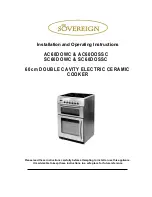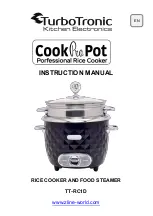
9
COOKING UTENSILS
For best cooking results and economy of operation use heavy
based, flat bottomed utensils.
n
IMPORTANT: WE DO NOT RECOMMEND DEEP FAT
FRYING ON THIS APPLIANCE.
n
IMPORTANT: DO NOT USE MIS-SHAPED PANS WHICH
MAY BE UNSUITABLE DO NOT USE ROUND BASED
WOKS.
CLEANING
n
IMPORTANT: BE CAREFUL OF THE HOT APPLIANCE.
General cleaning must be carried out when the cooker is cool.
Rayburn cookers are finished in a high gloss vitreous enamel.
To keep the enamel in the best condition observe the
following tips:
1.
Wipe over daily with a soapy damp cloth, followed by a
polish with a clean dry duster.
2.
If milk, fruit juice or anything containing acid is
spilt on the hob or down the cooker, be sure to
wipe it immediately or the vitreous enamel may be
permanently discoloured.
3.
Keep a damp cloth handy while cooking, to wipe up any
spills as they occur, so they do not harden and become
more difficult to remove later.
4.
If spills do become baked on, a cream cleanser can be
used. For stubborn deposits a soap impregnated pad
can be carefully used on the vitreous enamel.
5.
Use only products recommended by the Vitreous
Enamel Association, these products carry the Vitramel
label.
6.
In the oven, spills and fat splashes are carbonised at
high temperatures: occasionally brush out with a stiff
brush. The shelves can be soaked and cleaned with a
cream cleanser.
7.
Both insulating covers should be raised and allowed
to cool before cleaning the enamel with a soapy damp
cloth. Use a wire brush to keep the cast iron hotplate
clean.
DO NOT USE ABRASIVE PADS OR OVEN CLEANERS
CONTAINING CITRIC ACID ON ENAMELLED SURFACES.
ENSURE THAT THE CLEANSER MANUFACTURERS
INSTRUCTIONS ARE ADHERED TO.
CHIMNEY CLEANING
Whichever type of flue is chosen, there must be cleaning
access to the whole of the flue system. The flue of the
chimney will need to be cleaned regularly. The combustion
products of any burning appliance will have a descaling effect
on hardened soot deposits left from burning solid fuels.
Although, the chimney may have been cleaned of loose
soot prior to installation, it is imperative that the chimney
is inspected for scaled soot particles after the first month of
operation and any loose material removed to avoid blockage.
The frequency of cleaning will depend a lot on how your
cooker is run, but to start with, make a point of inspecting
the flue system every six months. This period may well be
extended to twelve months as time goes by if there is little
sign of deposits.
MILD STEEL
The steel panels and splash back (if fitted) must not be
cleaned with steel wool. Use only washing up liquid in hot
water with a lint free cloth. Dry off and apply a coat of good
quality furniture polish.
OVENS
Grease spillages will burn off from the oven interior, when
the oven is hot and any other loose materials can be wiped
out with a cloth, when cold. Stubborn stains in the area and
on the shelves in the oven can be cleaned off with a paste of
bread soda and water
HOTPLATE
The hotplate may be cleaned by using a fine steel wool pad
to remove rust or cooking stains. Dry off with a lint free cloth
and apply a light coat of cooking oil to preserve the finish.














































